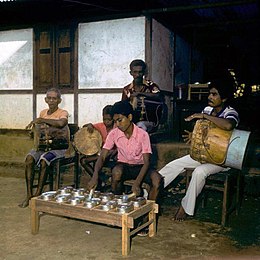 A Tifa totobuang ensemble, a traditional musical instrument from the East Indonesia region | |
| Classification | |
|---|---|
| Developed | Indonesia (Maluku) |
| Playing range | |
| Pelog and Slendro scales | |
| Related instruments | |
| bonang, kenong, canang, keromong, kromong, kethuk, trompong/terompong, rejong, khong wong yai/khong wong lek, khong toch/ khong thom, khong vong, krewaing/krewong | |
| More articles or information | |
 |
| Music of Indonesia |
| Genres |
|---|
| Specific forms |
|
|
|
|
| Regional music |
A tifa totobuang is a music ensemble from the Maluku Islands, related to the kulintang orchestra. It consists of a set of a double row of gong chimes known as the totobuang (similar to set of bonang gong chimes) and a set of tifa drums. It can also include a large gong.[1]
The name comes from the instruments' collaboration. The ensemble can accompany the Maluku Island's Sawat Lenso dance.[2][3]
The custom dates back at least to the late 17th or early 18th century. Gong-chime and drum ensembles, labeled tifa totobuang, were mentioned by François Valentijn, a Dutch army cleric who served in the Dutch army in Ambon, Maluku in two tours, 1686-1994 and 1703–1713.[4] Valentijn talked about hearing "some Javanese lasses sing to the sound of a gong and a tifa (i.e. drum) and of a native zither...a large number of gongs and tifas."[5]
- ^ "19 Alat Musik Tradisional Indonesia (Universal Update) [translation: 9 Indonesian Traditional Musical Instruments (Universal Update)]". Archived from the original on 14 November 2013.
- ^ "Sawat Lenso, a Maluku dance which is a symbol of friendship between Muslims and Christians". British Broadcasting Corp., Indonesia. 19 January 2019.
- ^ Djarujm Foundation, IndonesiaKaya. "Tifa Totobuang".
[Video. From print on bottom of video:] The totobuang is a melodic musical instrument that has tones and is shaped like a Javanese gamelan instrument...The two are usually played together on the same day, which is why the collaboration is called tifa totobuang.
- ^ Margaret J. Kartomi (September 1995). ""Traditional Music Weeps" and Other Themes in the Discourse on Music, Dance and Theatre of Indonesia, Malaysia and Thailand". of Southeast Asian Studies. 26 (2). Cambridge University Press on behalf of Department of History, National University of Singapore: 367.
- ^ Jaap Kunst. Music in Java, Its history, its theory and its technique, 3rd edition. Vol. 1. The Hague: Martinus Nijhoff. p. 114.